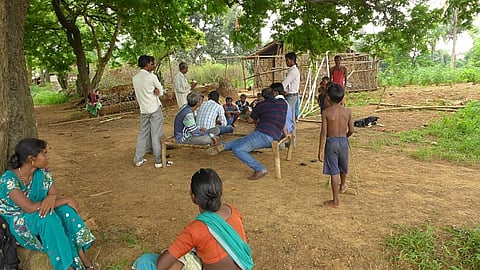
- Topics
- Feature
- Opportunities & Events
- Data
- Hindi Portal
- Topics
- Feature
- Opportunities & Events
- Data
- Hindi Portal

"The men say that the well is perennial", I said. "Do you use it"? "No", replied the women. "It might be perennial, but the water is unclean. Our dals don't cook, and there are sometimes worms in the water".
"The men have decided that one standpost tap for 20 households is enough. Do you agree"? "No! Who will waste the entire day standing in a queue? We want one for every 5 households".
These women didn't disagree just to oppose the men. Their responses were very relevant and carefully-considered. And these were just two of those that were received from the women who participated in a village planning exercise in rural Jharkhand. Had I not been there, goading the male meeting participants into addressing them, the women would not have been consulted at all!
But there is no such thing as partial participation; it is all or nothing.
"When women come to village meetings, they see their inlaws sitting there- maybe a father-in-law, maybe their husbands. It is quite impossible for them to speak in front of these relatives, let alone contradict them. However, it is also true that women know most about their water sources and their water needs", said Ganga Bisht, the programme head at CHIRAG. "We decided to make sure they alone controlled this management but we failed".
The team had first attempted to include women's voices by excluding those of the men. The programme called for villagers to get together into small groups that would study their spring, implement restoration measures, and come up with a system for equitable water use. For this, the CHIRAG team formed women-only water management groups (Jal Samitis). As they later learned, these did not work very well.
Excluding men is as counterproductive as excluding women. All the adults living in the vicinity of a spring turned out to have a role in its management. The team reassessed the situation and decided to include both men and women in the spring management committees. To shake up the traditional hierarchy, the positions of authority in the committees (President and Secretary) would be held by women.
Here, Ganga ran into a second obstacle- her team. Like the team in Jharkhand, the one in Uttarakhand was well-intentioned but clueless about how to begin. They did try, but the largely-male team was unable to strike a rapport with the women. Perhaps they were not entirely convinced either. Ganga now discussed this with her boss, Mukul Prasad, and they decided to bring in help. That's when Nandini Rao entered into the picture.
Ganga, Mukul, and Nandini chalked out a year-long programme of meetings and workshops with the CHIRAG staff and
spring committees. The idea behind including Nandini was to bring in all the weight of the opinion of an 'external expert' and to use the various tools that she was able to use to communicate awareness about inclusion. The strategy worked better than Mukul and Ganga had hoped. Partly through her tools but mostly through her outspoken intolerance for any discrimination, Nandini created a cadre of converts.